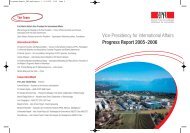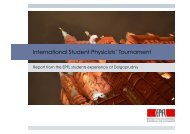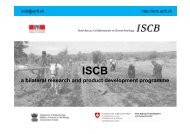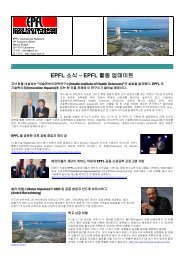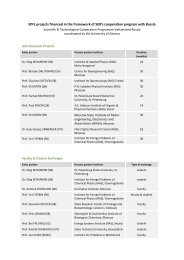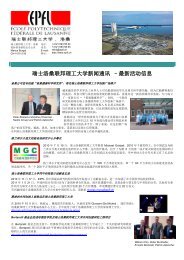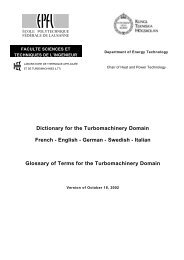Science & Technology News from Japan - International Relations
Science & Technology News from Japan - International Relations
Science & Technology News from Japan - International Relations
You also want an ePaper? Increase the reach of your titles
YUMPU automatically turns print PDFs into web optimized ePapers that Google loves.
Schweizerische Eidgenossenschaft<br />
Confédération suisse<br />
Confederazione Svizzera<br />
Confederaziun svizra<br />
Embassy of Switzerland in <strong>Japan</strong><br />
State Secretariat for Education and Research SER<br />
Nuclear Energy Systems & Services Division, and president of the Power Systems Company. Meanwhile, Takashi<br />
Kawamura, currently chairman of the board of both Hitachi Plant Technologies Ltd. and Hitachi Maxell Ltd. is to<br />
become representative executive officer, chairman, president and CEO of Hitachi.<br />
Positron-Imaging To Observe Substance-Movement In Living Plant<br />
(March 31, 2009)<br />
The <strong>Japan</strong> Atomic Energy Agency (JAEA) and Niigata University have jointly developed a plant positron-imaging<br />
technology that can observe the movements of various substances in living plants through the use of radioactive<br />
tracers. The Agency newly produced a radioactive nitrogen gas and established a method for purifying the gas<br />
promptly and administering it to a plant. This was the first time in the world that soybean root nodules had been<br />
successfully observed absorbing nitrogen in their natural condition. Based on the image data, JAEA has been able<br />
to find a practical use for the measurement of the nitrogen fixation ability of soybean root nodules.<br />
10. Physics<br />
High Efficient Method To Extract Light From Semiconductors<br />
(March 17, 2009)<br />
Research Institutes discovered that more than 50% of the spontaneous emission light generated<br />
in semiconductors with microscopic V-grooves is emitted into the air and have<br />
succeeded in explaining the mechanism. Semiconductor light-emitting materials are formed<br />
on substrates with microscopic V-grooves. When the light produced in the semiconductor<br />
material is totally reflected at the semiconductor-air interface, evanescent waves are<br />
generated. Due to the V-shaped surface structure of the material, evanescent waves<br />
originated <strong>from</strong> different crystal surfaces interfere with each other, and are transformed into light propagating in air<br />
with an efficiency of greater than 50%.<br />
Silicon’s Giant Magnetoresistive Effect In High Electric Field<br />
(March 18, 2009)<br />
Kyoto University has discovered that silicon exhibits significant changes in its electrical resistance in a high electric<br />
field. The phenomenon is called a 'giant magnetoresistive effect' and has contributed to radical improvements in the<br />
performance of PC hard disks and magnetic sensors. The discoverer of the effect won the Nobel Prize in Physics<br />
for 2007. As a semiconductor material, silicon has been studied intensively for more than 50 years, but its magnetoresistive<br />
effect had not been known. This may help the development of magnetic memory devices made of silicon,<br />
an inexpensive material.<br />
Secondary Beam Line In Hadron Experimental Hall Completed<br />
(March 31, 2009)<br />
The Nuclear and Particle Physics Facility (Hadron Experimental Hall) inside the <strong>Japan</strong> Proton Accelerator Research<br />
Complex (J-PARC) at Tokai Village recently completed work on constructing the secondary particle beam<br />
line "K1-8BR," using it to successfully produce and transport secondary particle beams. The facility is co-owned by<br />
JAEA and the High-Energy Accelerator Research Organization (KEK) and will use proton beams of great intensity<br />
to produce secondary particle beams containing large amounts of K mesons, π mesons, antiprotons and muons for<br />
use in research in such fields as subatomic physics and nuclear physics.<br />
11. Intellectual Property Rights / <strong>Technology</strong> Transfer / Alliances<br />
DRAM <strong>Technology</strong> And Patents For New Governmental Taiwan Firm<br />
(March 09, 2009)<br />
Taiwan will set up a company to attract overseas technology, including <strong>from</strong> <strong>Japan</strong>, for the manufacture of dynamic<br />
random access memory chips in a bid to rescue the island's DRAM industry. The Ministry of Economic Affairs' plan<br />
to establish the ''Taiwan Memory Co.'' The company's primary goal will be to solicit overseas DRAM technology<br />
and patents -- especially <strong>from</strong> Elpida Memory Inc., <strong>Japan</strong>'s biggest chipmaker, and U.S. chipmaker Micron <strong>Technology</strong><br />
Inc. -- in exchange for aid or financing <strong>from</strong> Taipei. With overseas patents and technology <strong>from</strong> Elpida and<br />
Micron in its possession, the company would be positioned to share those assets with local chipmakers.<br />
<strong>Science</strong> & <strong>Technology</strong> <strong>News</strong> <strong>from</strong> <strong>Japan</strong>, Template 2009 • Felix Moesner, <strong>Science</strong> & <strong>Technology</strong> Attaché Page 26 of 28









